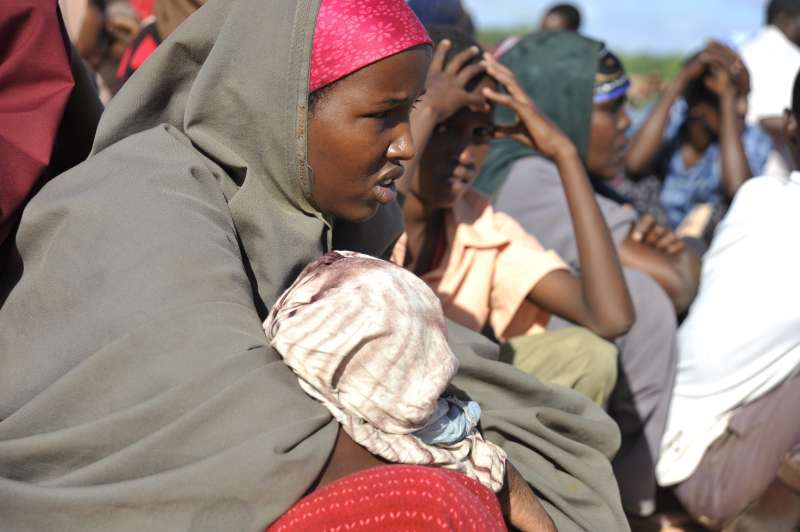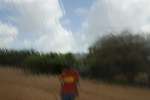UNHCR urges Kenya to halt forced return of Somali refugees
News Stories, 3 November 2010

© UNHCR/R.Gangale
Somali refugees at a camp in north-eastern Kenya.
GENEVA, November 3 (UNHCR) – The UN refugee agency on Wednesday called on the Kenyan government to immediately halt its returns of Somalis from a border camp in the north-east of the country.
In a press statement released in Geneva, UNHCR said it was making this appeal "in light of orders issued by local authorities to the more than 8,000 refugees at the [Border Point One] camp, telling them to cross the border back into Somalia. As of yesterday [Tuesday] some refugees had proceeded into no-man's land."
"We urge Kenya's government to urgently halt further returns and allow those in no-man's land to come back," the statement said.
A UNHCR team visited the area on Wednesday after receving several phone calls from desperate refugee leaders. The team confirmed that one group of Somalis was in the no-man's land between Kenya and Somali while a second group had moved towards the border with Ethiopia.
The press statement said UNHCR, in its advice to governments, had made clear that people fleeing central and southern Somalia were at substantial risk and that their international protection needs must be respected.
The population at the Border Point 1 camp mainly comprises children, women and the elderly – all of whom have fled there to escape recent fighting between Al-Shabaab and Ahlu Sunna Wal Janaa forces in the Somali town of Bulla Hawa.
Kenya has for many years generously hosted tens of thousands of Somali refugees. "To be forcibly returning people to Somalia now betrays that spirit, places lives at risk and contravenes the principles of non-refoulement – or non forced return – that are contained in Kenya's Constitution, its Refugees Act and in international refugee law," the UNHCR statement said.
Advocacy is a key element in UNHCR activities to protect people of concern.
Crossing the Gulf of Aden
Every year thousands of people in the Horn of Africa - mainly Somalis and Ethiopians - leave their homes out of fear or pure despair, in search of safety or a better life. They make their way over dangerous Somali roads to Bossaso in the northern semi-autonomous region of Puntland.
In this lawless area, smuggler networks have free reign and innocent and desperate civilians pay up to US$150 to make the perilous trip across the Gulf of Aden.
Some stay weeks on end in safe houses or temporary homes in Bossaso before they can depart. A sudden call and a departure in the middle of the night, crammed in small unstable boats. At sea, anything can happen to them - they are at the whim of smugglers. Some people get beaten, stabbed, killed and thrown overboard. Others drown before arriving on the beaches of Yemen, which have become the burial ground for hundreds who many of those who died en route.
Crossing the Gulf of Aden
Somalia/Ethiopia
In February 2005, one of the last groups of Somalilander refugees to leave Aisha refugee camp in eastern Ethiopia boarded a UNHCR convoy and headed home to Harrirad in North-west Somalia - the self-declared independent state of Somaliland. Two years ago Harrirad was a tiny, sleepy village with only 67 buildings, but today more than 1,000 people live there, nearly all of whom are former refugees rebuilding their lives.
As the refugees flow back into Somalia, UNHCR plans to close Aisha camp by the middle of the year. The few remaining refugees in Aisha - who come from southern Somalia - will most likely be moved to the last eastern camp, Kebribeyah, already home to more than 10,000 refugees who cannot go home to Mogadishu and other areas in southern Somalia because of continuing lawlessness there. So far refugees have been returning to only two areas of the country - Somaliland and Puntland in the north-east.
Somalia/Ethiopia
Flood Airdrop in Kenya
Over the weekend, UNHCR with the help of the US military began an emergency airdrop of some 200 tonnes of relief supplies for thousands of refugees badly hit by massive flooding in the Dadaab refugee camps in northern Kenya.
In a spectacular sight, 16 tonnes of plastic sheeting, mosquito nets, tents and blankets, were dropped on each run from the C-130 transport plane onto a site cleared of animals and people. Refugees loaded the supplies on trucks to take to the camps.
Dadaab, a three-camp complex hosting some 160,000 refugees, mainly from Somalia, has been cut off from the world for a month by heavy rains that washed away the road connecting the remote camps to the Kenyan capital, Nairobi. Air transport is the only way to get supplies into the camps.
UNHCR has moved 7,000 refugees from Ifo camp, worst affected by the flooding, to Hagadera camp, some 20 km away. A further 7,000 refugees have been moved to higher ground at a new site, called Ifo 2.
Posted in December 2006
Flood Airdrop in Kenya


Return to Somalia
Ali and his family are ready to return to Somalia after living in Dadaab refugee camp for the past five years. We follow their journey from packing up their home in the camp to settling into their new life back in Somalia.


Kenya: High Commissioner Visits Dadaab Refugee Camp
Last week the UN High Commissioner for Refugees, António Guterres completed a visit to Kenya and Somalia where he met with the Presidents of the two countries, as well as Somali refugees and returnees.


Kenya: A Lifetime of Waiting
Sarah was born and raised in Hagadera refugee camp in Dadaab, Kenya. Now 21, she has become a wife and mother without ever setting foot outside the camp.
 |
|  |
|  |
| 















































